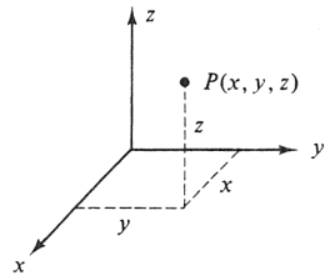Section 2.2 - Vectors in three dimensions
Section Objectives
- Distinguish 3-dimensional space from 2-dimensional space.
- Work with the rectangular coordinate system in 3-space.
- Perform and describe basic operations on vectors in 3-space.
- Compute the magnitude of a vector in 3-space.
Introduction
To move beyond 2-space into 3-dimensional space, we introduce the -axis into our standard rectangular coordinate system. The -, -, and -axes are mutually perpendicular, sharing the common point at the origin. Points in space are identified with three ordered triplets, .

The arrangement of the axes satisfies the right-hand rule: with your right hand, point your fingers in the direction of the positive -s, curl your fingers toward the positive -axis, and your thumb will point in the direction of the positive -axis. However you envision (or sketch) your axes, make sure they follow the right-hand rule!
Examples
- Distance formula: The distance from to is given by . Find the distance from to .
- Midpoint formula: The midpoint of the segment connecting to is . Find the midpoint of the segment , where and are the points above.
- The sphere with center and radius is described in standard form by the equation . Find the center and radius of the sphere described by .
- Describe the surface in 3-space given by the equation .
- Describe the surface in 3-space given by .
Vectors in space
Except for concepts involving slope and and the -axis angle (), vectors in 2-space generalize nicely to vectors in 3-space. Vectors in 3-space have three components, and the basis vectors are now
As before, the basis vectors are the unit vectors in the directions of the coordinate axes.
Examples
- Determine a vector of magnitude whose direction is opposite that of the vector from to .
- Let , , and . Find the magnitude of .
Parallel vectors
Vectors are parallel if they have the same or opposite directions. It is perhaps easiest to think about this idea in terms of scalar multiplication: Two vectors are parallel if and only if one is a scalar multiple of the other. That is
- Find the number so that and are parallel.
- Show that the points , , and are not collinear.